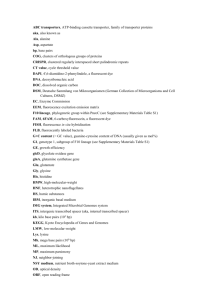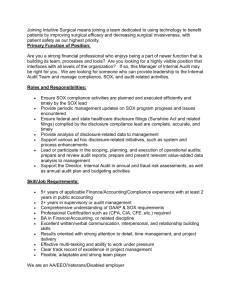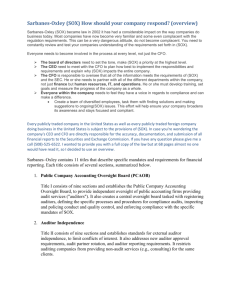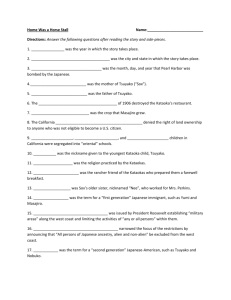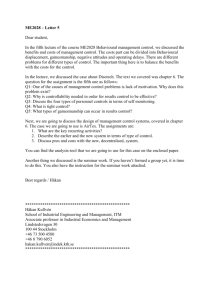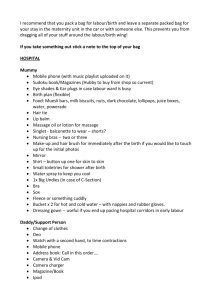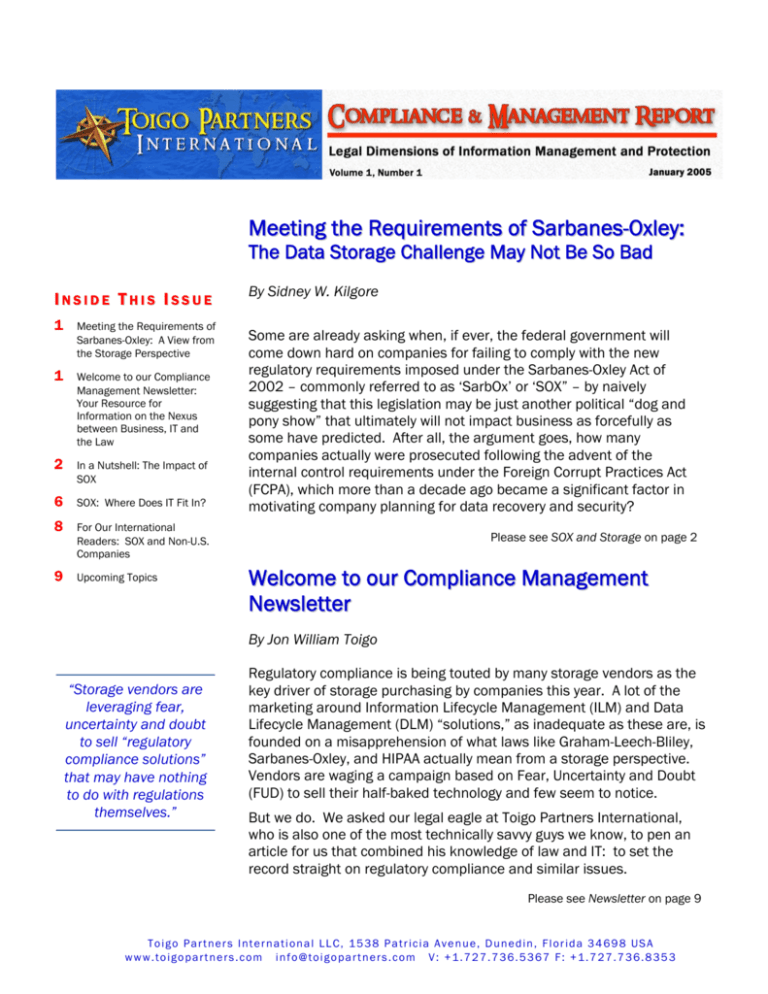
Meeting the Requirements of Sarbanes-Oxley:
The Data Storage Challenge May Not Be So Bad
INSIDE THIS ISSUE
1
Meeting the Requirements of
Sarbanes-Oxley: A View from
the Storage Perspective
1
Welcome to our Compliance
Management Newsletter:
Your Resource for
Information on the Nexus
between Business, IT and
the Law
2
In a Nutshell: The Impact of
SOX
6
SOX: Where Does IT Fit In?
8
For Our International
Readers: SOX and Non-U.S.
Companies
9
Upcoming Topics
By Sidney W. Kilgore
Some are already asking when, if ever, the federal government will
come down hard on companies for failing to comply with the new
regulatory requirements imposed under the Sarbanes-Oxley Act of
2002 – commonly referred to as ‘SarbOx’ or ‘SOX” – by naively
suggesting that this legislation may be just another political “dog and
pony show” that ultimately will not impact business as forcefully as
some have predicted. After all, the argument goes, how many
companies actually were prosecuted following the advent of the
internal control requirements under the Foreign Corrupt Practices Act
(FCPA), which more than a decade ago became a significant factor in
motivating company planning for data recovery and security?
Please see SOX and Storage on page 2
Welcome to our Compliance Management
Newsletter
By Jon William Toigo
“Storage vendors are
leveraging fear,
uncertainty and doubt
to sell “regulatory
compliance solutions”
that may have nothing
to do with regulations
themselves.”
Regulatory compliance is being touted by many storage vendors as the
key driver of storage purchasing by companies this year. A lot of the
marketing around Information Lifecycle Management (ILM) and Data
Lifecycle Management (DLM) “solutions,” as inadequate as these are, is
founded on a misapprehension of what laws like Graham-Leech-Bliley,
Sarbanes-Oxley, and HIPAA actually mean from a storage perspective.
Vendors are waging a campaign based on Fear, Uncertainty and Doubt
(FUD) to sell their half-baked technology and few seem to notice.
But we do. We asked our legal eagle at Toigo Partners International,
who is also one of the most technically savvy guys we know, to pen an
article for us that combined his knowledge of law and IT: to set the
record straight on regulatory compliance and similar issues.
Please see Newsletter on page 9
Toigo Partners International LLC, 1538 Patricia Avenue, Dunedin, Florida 34698 USA
www.toigopartners.com info@toigopartners.com V: +1.727.736.5367 F: +1.727.736.8353
Compliance Newsletter
Page 2
SOX and Storage from page 1
THE IMPACT OF SOX IN A
NUTSHELL
WHO IS AFFECTED?
U.S. and non-U.S. companies.
Companies whose securities are
registered under Section 12 of the
1934 Act (public companies), who
are required to file reports under
Sections 13(a) of 15(d) of the
1934 Act, or who have filed a
registration statement under the
1933 Act are subject to SOX.
Even private companies not
currently falling within any of these
criteria will need to take heed of
SOX if they harbor aspirations of
launching an IPO one day or
otherwise if they may become nonexempt.
Officers and Directors. Among
other things, CEOs and CFOs must
certify that information contained
in company annual and periodic
reports fairly represents, in all
material respects, the financial
condition and results of operation
of the company, and can be held
personally liable, civilly and
criminally, for non-compliance with
SOX.
Employees. New whistleblower
provisions are intended to insulate
employees of a company from
retaliation for reporting
questionable activities.
Company Securities Lawyers. SOX
obligates attorneys to report
violations of securities laws or
breaches of fiduciary duty to the
CEO, general counsel, legal
compliance committee, or in some
cases, to the Board of Directors of
a company.
Continues next page
Such dangerous speculation should not entice company
management to retreat from compliance initiatives under SOX, which
represents a substantial step in a continuous evolutionary chain of
federal regulation of the accountability of public corporations going
back more than 70 years. The requirements of SOX are indeed real,
and breathe new life and power into the FCPA and a number of other
existing laws through the establishment of a comprehensive scheme
of certification to ensure the accuracy, integrity, and completeness
of the financial information on which investors and regulators must
rely, as well as substantial civil and criminal consequences for those
who fail to comply, including individual members of corporate
management, company counsel, and accountants.
These features make SOX fundamentally different from any previous
attempts by the government to prevent corporate corruption and
fraud in publicly traded companies. Recent reports suggest that
while Treasury Secretary John Snow has expressed concerns about
the need for “balance” in enforcement of SOX to obviate criminal
prosecutions for mere mistakes, he also has made it clear that in his
view, SOX remains important as a reaffirmation of standards of good
corporate practice, and that there no need for Congress to amend
SOX as originally enacted. SOX therefore represents a new paradigm
for corporate governance and operation that is here to stay.
Putting SOX In Historical Context
Since the early 1930s, Congress has sought to codify requirements
for controls within organizations, both to control the growth of these
organizations and to protect from fraud investors who require
accurate information about companies in order to make sound
investment decisions. Such legislative initiatives often follow in the
wake of a major financial crisis or a series of substantial compliance
failures.
For example, concerns about corporate deceit, fraud and
misrepresentation in the wake of the stock market crash which
heralded the Great Depression gave rise to the Securities Act of
1933 (the 1933 Act) and the Securities Exchange Act of 1934 (the
1934 Act). Together, these laws established standards for the
dissemination of information by companies to prospective investors,
created the Securities and Exchange Commission (SEC), and
formulated reporting requirements with respect to publicly traded
securities. The overriding purpose of this regulatory framework was
to protect prospective purchasers of publicly traded securities –
stocks, bonds, and so forth – by requiring that they be provided with
truthful financial and other material information about the securities
Please see SOX and Storage on page 3
Page 3
Compliance Newsletter
SOX and Storage from page 2
that, in turn, would allow them to make informed judgments about
investments in the company.
The FCPA, first passed in 1977, and subsequently amended in 1988
and 1998, amended the 1934 Act. Intended to stem widespread
bribery of foreign officials by U.S. companies – which evidently was
interfering with U.S. foreign policy and generally deemed to be a bad
thing – the FCPA required management to implement accounting and
internal control procedures that accurately and fairly reflected corporate
transactions. Although mandating such procedures, the FCPA imposed
no clear obligation on the part of company management to ensure the
effectiveness of those procedures, which proved a significant loophole
in terms of its enforcement.
The passage of SOX in 2002 came on the heels of corporate scandals
involving Enron, Worldcom, Tyco, and other huge companies, which
exposed the limited effectiveness of existing regulations as a
prophylactic measure against fraud, especially when committed by
company management, with the aid and comfort of unscrupulous
attorneys and accountants. Intended to restore the confidence of
investors in publicly traded companies, SOX created a new set of
standards actually calculated to prevent fraudulent financial reporting
by companies and to improve detection of company fraud when it
occurs.
Among other things, SOX effectively amended the internal control
provisions imposed under the FCPA by requiring the Chief Executive
Officers (CEOs) and Chief Financial Officers (CFOs) of certain public
companies to certify both the accuracy of the company’s books and
records, and the internal controls used to produce and verify those
books and records. While a number of companies already had
documented their internal controls in response to the FCPA through the
creation of policy manuals and the like, they typically lacked the
documentation necessary for management to evaluate the efficacy of
those internal controls in accordance with the certification and
disclosure requirements of SOX.
Although the SEC twice in the past had proposed that companies be
required to report on the effectiveness of their internal controls and
procedures for financial reporting – first in 1979 following the
enactment of the FCPA, and again in 1988 following recommendations
by the Treadway Commission, an independent private sector initiative
created in 1985 to identify the causes of fraudulent financial reporting –
neither proposal had come to fruition.
Please see SOX and Storage on page 4
Continued from previous page…
Company Auditors. Firms which
perform audits on companies
must be registered with an SEC
audit review board and must
attest to and report on the
assessment by management of
the efficacy of the internal
controls and operating
procedures it has established,
and face new restrictions on and
standards for the services they
provide.
Investment Banks and Research
Analysts. Enhanced regulations
require greater disclosure of
actual and potential conflicts of
interest.
-SWK
“SOX created a new set
of standards actually
calculated to prevent
fraudulent financial
reporting by companies
and to improve
detection of fraud when
it occurs.”
Page 4
SOX and Storage from page 3
Disclosures of the assessment of corporate
management as to the effectiveness of
company controls, to be made under SOX in
accordance with SEC-promulgated rules,
could potentially raise the stakes for officers
and directors by requiring incidents of fraud
or other legal transgressions, e.g., violations
of the FCPA to be revealed in company filings
with the SEC. This contrasts with the preSOX environment, in which the board of
directors of a company arguably could have
met its obligations to deal with such matters
quietly by simply documenting the remedial
steps taken by the company in response to
the problem, including its internal
investigations, the correction of errors in its
books and records, and the imposition of
appropriate disciplinary procedures on those
individuals responsible.
In the new SOX era, then, companies actually
may need to consider making advanced
voluntary disclosures to the Department of
Justice (DOJ) of violations of law and
regulations that ultimately will come out in
their SEC filings, since under the so-called
“qualitative materiality standard” of
disclosure for financial statements
established by the SEC in Staff Accounting
Bulletin No. 99 (dated 12 August 1999),
non-disclosure of an FCPA violation, for
example, may reflect adversely on the
integrity of management. Moreover, such
voluntary disclosure may obviate a criminal
referral from the SEC to the DOJ as a
consequence of the non-disclosure of an
FCPA violation in company financial
statements.
To further ensure the honesty and integrity of
financial statements, and of the certification
of those statements by company
management, SOX requires public
accounting firms performing company audits
to evaluate whether the internal control
structures and procedures of the company
include records that accurately reflect its
transactions and disposition of its assets.
Compliance Newsletter
This evaluation must include a description
of material weaknesses in those internal
controls, and a statement of any material
noncompliance found during the audit.
In order to conduct a company audit, an
accounting firm must first register with the
Public Company Accounting Oversight
Board (PCAOB). The PCAOB is a fivemember body established by SOX to
operate under the aegis of the SEC for the
purpose of providing oversight of the audit
of public companies, establishing audit
standards and rules, and inspecting,
investigating, and enforcing compliance by
the public accounting firms registered with
it. Disciplinary or remedial sanctions, or
both, may be imposed by the PCAOB on
those registered firms and their affiliates in
the event of intentional conduct or
repeated negligence in carrying out their
responsibilities under SOX. Presumably,
these requirements will act to stem the
opportunity for fraud by precluding the sort
of collusion between company
management and auditors that occurred in
the case of Enron and Arthur Anderson.
So what are the consequences to
corporate officers and directors who fail to
comply with the new reporting
requirements under SOX? They are harsh,
to say the least.
For example, Section 906, which
establishes criminal liability for the failure
of corporate officers to certify properly that
the information contained in company
financial reports “fairly presents, in all
material respects, the financial condition
and results of operations of the issuer,”
authorizes fines of up to $1,000,000 and
imprisonment for up to 10 years for those
officers who certify any statement knowing
that the periodic report accompanying the
statement does not comport with this
requirement.
Please see SOX and Storage on page 5
Page 5
Compliance Newsletter
SOX and Storage from page 4
If the violation is deemed to be “willful,” the
maximum fine becomes $5,000,000, and the
maximum prison term 20 years. A number of
other criminal penalties are substantially
enhanced, too.
Penalties for violations of the 1934 Act, for
instance, are increased under SOX to a maximum
fine of $25,000,000, and a maximum prison term
of 20 years, while penalties for mail and wire
fraud expand from a maximum of 5 to 20 years in
prison.
On the civil side, in the event a company must
restate its accounting due to material noncompliance, SOX requires the CEO and CFO of the
company to forfeit bonuses and compensation
they have received for a period of one year from
the original issue or filing date of the accounting
statement which required restatement.
SOX also creates an extension in the statute of
limitations applicable to private rights of action for
securities fraud, allowing such actions to be filed
within 2 years of discovery or 5 years of the first
occurrence of the alleged fraudulent event. The
failure to take the requirements of SOX seriously
carries substantial adverse consequences for the
company and for those who run it.
A Key Problem for Data Storage Managers
In a nutshell, compliance with SOX boils down to
providing accurate disclosures, on a real-time
basis, of any material information which could
affect company financial statements through an
adequate internal control structure and
procedures for financial reporting, the
effectiveness of which have been evaluated by
management, and confirmed by an independent
auditor, who must report on management’s
assessment of the effectiveness of the internal
controls it has established.
SEC rules to implement the internal control
provisions of SOX make it clear that in order to
provide reasonable assurance regarding the
reliability of financial reporting, a company’s
policies and procedures must:
1)
include the maintenance of records in
reasonable detail, accurately and
fairly reflecting the transactions and
dispositions of the assets of the
company;
2)
provide reasonable assurance that
transactions are recorded as
necessary to produce financial
statements in accordance with
Generally Accepted Accounting
Principles (GAAP);
3)
provide reasonable assurance that no
receipts and expenditures of the
company are being made without
authorization of company
management; and
4)
provide reasonable assurance that
any unauthorized acquisition, use, or
dispostion of the assets of the
company that could have a material
effect on its financial statements will
be prevented or, at least, detected in
a timely fashion.
Data storage therefore becomes an integral part
of the internal control process. The central
problem for data storage managers is to
determine, out of the deluge of data a company
creates, exactly which information will require
special treatment and handling to meet the
requirements of SOX. What records are required
to “accurately and fairly” reflect the transactions
and dispositions of the assets of a company?
SOX Dictates Data Storage Ends, Not Means
Contrary to the views expressed by a host of
well-meaning, but legally ill-informed,
commentators on the World Wide Web, SOX
does not set out any specific requirements for
data retention for companies. Rather, SOX
Please see SOX and Storage on page 6
Page 6
Compliance Newsletter
SOX and Storage from page 5
leaves it up to company management to
determine what information and records should
be kept, and for how long, in conjunction with the
establishment and maintenance by management
of an adequate control structure and procedures
for financial reporting, as required under Section
404.
Whatever management puts in place, however,
must meet the goal of providing reliable financial
information to investors, and management must
provide “reasonable assurance” that it does so.
Essentially, data pertaining to any event –
whether financial, operational, or otherwise – that
could impact company profit or loss, stock values,
or the attainment or failure of business goals, or
which would increase or decrease legal exposure
or other risk, or which would otherwise materially
affect the financial condition of the company,
should be retained.
Such data would include not only standard
balance sheet and income statement records, but
records pertaining to off-balance sheet
transactions as well. Account should be taken,
too, of data which is not captured electronically if
it is required for SOX compliance.
The starting point for assessment is to create an
inventory of existing internal control
documentation, determine what potential gaps in
controls may exist, develop a strategy for closing
those gaps, and then implement procedures for
validating and capturing the requisite data in real
time, or as close to real time as possible. On an
ongoing basis, efforts should be made at
improving the quality of the data, and reconciling
data inconsistencies.
Company management must ultimately make a
subjective determination based on reasoned
judgment as to what categories of records could
be of a material nature. This best may be
accomplished in consultation with company
auditors, who will eventually be attesting to and
reporting on management’s evaluation of its own
internal controls.
SOX: WHERE DOES INFORMATION
MANAGEMENT FIT IN?
IT will play a central role in assisting
management to develop and implement
an internal control framework which
captures, preserves, and makes available
on a real-time basis accurate information
regarding all material information which
may affect the reliability of the financial
statements and reports of a company,
and in documenting and evaluating the
efficacy of that framework.
The final rule for SOX promulgated by the
SEC recommends the use of a model
framework for enterprise risk
management developed by the
Committee of the Sponsoring
Organizations of the Treadway
Committee (COSO), whose web site is
located at www.coso.org.
IT managers may wish to consider
integrating the COSO framework with a
suitable IT control framework, such as
the Control Objectives for Information
and Related Technology (COBIT) model
developed by the IT Governance Institute
and available at www.itgi.org.
Continues Page 7
To illustrate, a hundred e-mail messages
between a company employee and a
foreign customer that reflect ongoing
negotiations leading to a multi-million
dollar contract may not have any material
bearing on the financial condition of the
company at all. On the other hand, they
might well become material if they were
Please see SOX and Storage on page 7
Page 7
Compliance Newsletter
SOX and Storage from page 6
to reference, for example, a bribe payment in
violation of the FCPA.
Again, the idea behind SOX is to achieve financial
transparency by ensuring that the records of the
company fairly and accurately reflect its business
transactions and any dispositions of its assets,
and that if fraud occurs, it is prevented, or at least
exposed quickly so that prompt remedial action
may be taken to mitigate any potential financial
impact on the company.
Continued from Page 6…
To address adequately the legal requirements
of SOX, IT departments would likely need to
consider and evaluate the following critical
issues:
•
Reliability. Procedures must be
established to ensure that SOXrequired data going into the system is
accurate at the time of entry, and that
the integrity of the data is preserved
and protected from corruption. SOX
data may need to be segregated from
other data, and may even require its
own discrete storage.
•
Security. Means must be implemented
to prevent unauthorized access to, and
modification or deletion of SOX data
through strong authentication and
authorization, as well as alerts and
detailed audit trail logs for each and
every access or attempt at access.
•
Disaster Recovery. SOX data must be
insulated from catostrophic failure due
to Acts of God and other unforseen
events.
•
Real-Time Access and Updating.
Information pertaining to any material
event which would impact the financial
condition or operations of a company
must be captured in real time and
made retrievable in real time.
•
Self-Evaluation and Reliability
Checking. Above all, the system must
provide means for auditing and
enhancing its own performance
through an iterative process of
assessing, validating, improving, and
reconciling SOX data.
--SWK
Apart from the decision about what records must
be kept, there remains the question of how to
treat SOX-required records. A common sense
approach is in order here.
•
First, the integrity of the records obviously
must be protected from unintended
alteration or deletion.
•
Second, the records must be protected
from unauthorized access, so a
mechanism for creating detailed audit
trails of any interaction involving the
records must be implemented.
•
Third, since Section 409 of SOX mandates
that companies must “disclose to the
public on a rapid and current basis such
additional information concerning material
changes in the financial condition or
operations of the [company] … as the [SEC]
determines, by rule, is necessary or useful
for the protection of investors and in the
public interest,” the records stored should
be continuously available in real time to
management for reference purposes.
At the end of the day, SOX requires company
management to provide a “reasonable assurance”
that its financial reporting is reliable, not a
guarantee that its financial data are flawless in
every respect. What reasonable CEO could argue
with the proposition that a company should
maintain current and reasonably reliable financial
data that accurately and fairly reflect its
transactions and any disposition of its assets?
What reasonable investor should not be entitled
to expect a publicly traded company to do so? Ω
Page 8
Compliance Newsletter
For Our International Readers:
Sox And Non-U.S. Companies
By Sidney W. Kilgore
Non-U.S companies and their auditors are not exempt from the
requirements of SOX. The SEC has stated bluntly, for example, that Section
404, which mandates that every corporate annual report required by either
13(a) or 15(d) of the 1934 Act contain an acknowledgement by
management of its responsibility for establishing and maintaining an
adequate internal control structure and procedures for financial reporting,
an assessment of the efficacy of that structure and those procedures, as
well as an attestation of and report on the same by an independent
auditor, “makes no distinction between domestic and foreign issuers and,
by its terms, clearly applies to foreign private issuers.” Basically, then, nonU.S. companies who have issued stock on U.S. exchange markets, or who
have otherwise registered their securities under the 1934 Act, must begin
to compliance as of its first fiscal year ending on or after 15 April 2005,
which effectively means 15 July 2005 forward. More than 1300 foreign
private issuers from 59 countries were registered with the SEC at the end
of 2001.
SOX is merely a recent example of the unfortunate propensity of the United
States to exercise extraterritorial jurisdiction – or extraterritoriality – to
regulate the activities of non-U.S. companies beyond its own borders. The
biggest problem arises when additional regulatory requirements are thrust
upon non-U.S. companies regarding matters to which they are already
subject to regulation in their home countries, such as the SOX requirement
of an independent audit committee, which in civil law countries could
unintentionally enhance the power of labor unions because their
representatives might be required by their domestic law to sit on the
committee and could therefore gain access to sensitive corporate
information that could improve its bargaining power in subsequent
negotiations.
From a technology standpoint, foreign company compliance with SOX may
present special complications. For example, how will implementation of
the requirement that companies be capable of providing real-time
disclosure of material changes in their financial conditions or operations be
affected by a presence in multiple time zones? To what extent will
linguistic differences in documentation impact such a requirement? What
additional steps may be necessary to meet the rule that foreign accounting
standards be referenced to the most directly related provision of Generally
Accepted Accounting Principles (GAAP), the U.S. standard for accounting?
All good questions that remain to be answered. Ω
Page 9
Compliance Newsletter
Newsletter from page 1
The article became a newsletter. And the
newsletter evolved into an important and valued
component of TPI’s informational service offerings.
Going forward, Mr. Kilgore will expand his subject
matter to include the legal issues affecting data
managers everywhere, from matters of intellectual
property rights to matters of personal privacy. And of
course, he will continue to monitor the nexus between
regulatory developments and IT.
Each issue will be a sort of “legal briefing” in layman’s
terms. While not a substitute for legal advice, by any
means, Kilgore’s commentary will provide the reader
with enough background to make better use of their
consultations with legal professionals.
The Compliance and Management Newsletter does not
accept vendor advertisement. Instead, we will seek to
cover our costs for bi-monthly publication through
reader subscriptions of only $600 per year or $100 per
issue.
Compliance & Management: Timely And
Accessible Legal Briefings That Busy
Information Managers Will Find Valuable
Everyone understands that knowledge is power. As an IT
professional, however, when do you have time to keep up
with legal developments that impact your business? Could
you be out of compliance with some new law or regulation
of which you aren’t even aware? Are there inexpensive
ways for you to minimize your company’s legal exposure
from dangers you know little or nothing about? Do
profitable opportunities exist that you aren’t taking
advantage of simply because you don’t understand the
legal avenues necessary to seize on those opportunities?
Every other month, this newsletter will explore legal topics
specially selected to help you fill in these gaps. Written in
concise and clear language you will appreciate, the articles
you will find in these pages will help to expand your grasp of
even relatively arcane legal subjects, and enable you to be
more proactive and effective in protecting your business
and finding an inside track to greater success. Forthcoming
issues will cover the following topics:
Those readers who elect to join our on-line
communities, IT-Sense (www.it-sense.org) for IT decision
makers or the Data Management Institute
(www.datainstitute.org) for data managers, will receive a
discounted subscription to the Newsletter as a member
benefit. Membership also provides access to a wealth
of other information resources including white papers
and other specialty newsletters covering data
management, legal matters pertaining to storage,
disaster recovery planning, information security, and
other useful topics.
•
Alternative Strategies for Vendor Sharing of
Proprietary Technology for Mutual Benefit
•
Limits of Employee Privacy in the Use of the
Computational Resources of an Employer
•
Status of Electronic Contracting in Commercial
Transactions
•
Jurisdictional Issues In TransBorder Flows of
Information
We welcome you to visit our sites today and learn more
about the benefits of membership.
•
Deciding Whether To Patent
Toigo Partners International
Data Management Institute
1538 Patricia Avenue
Dunedin, FL 34698 USA
Phone: +1.727.736.5367
Fax: +1.727.736.8353
E-mail: info@toigopartners.com
We invite you, the reader, to suggest additional topics that
would be of value to you. Email us at
info@toigopartners.com.
The Compliance and Management Newsletter is a
bi-monthly publication of Toigo Partners International and
the Data Management Institute. All content of this
publication is Copyright © 2005 by Toigo Partners
International LLC and Sidney W. Kilgore.
All rights are reserved.

